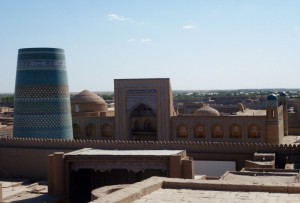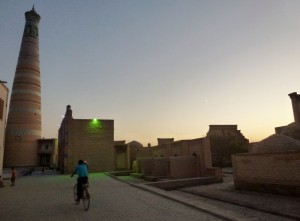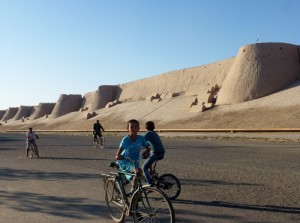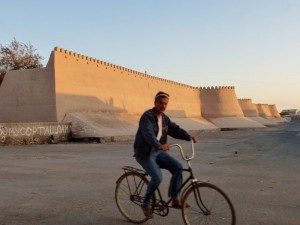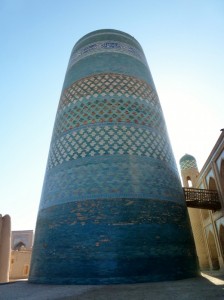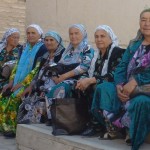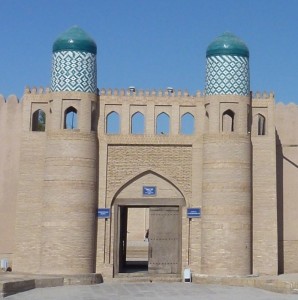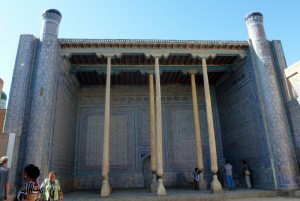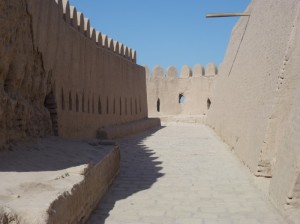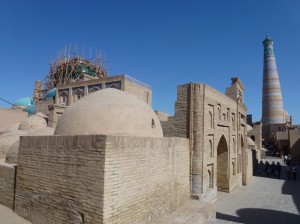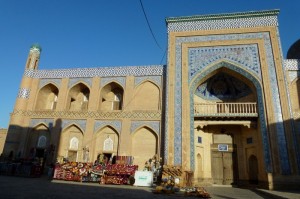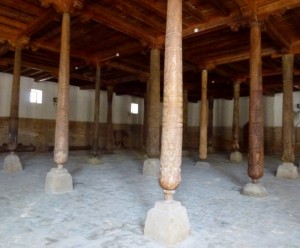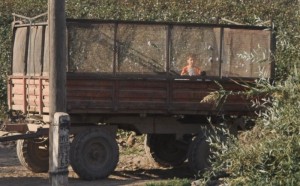Day 25 (August 19): Khiva
Our first stop was the Mohammed Amin Khan Medressa built in the 1850s which is now turned into a boutique hotel called Oriental Star Khiva. According to our guide, it was the first medressa that has been turned into a hotel in the country. (I went inside in the afternoon and found the place tastefully done up. This is one of the ways to make use of these beautifully buildings as long as the usage and decoration leaves the original architecture and atmosphere intact.) Next to the hotel is the iconic turquoise-titled Kalta Minor Minaret which was half-completed.
Opposite the Hotel is the Kukhna Ark (the fortress and residence of the Khiva rulers). The first was built in the 12th century by one of the Oq Shihbobo and expanded by the khans in the 17th century. We went to see the Zindon (the prison) which is outside the main complex. The Ark is large with a throne room, an old mint, a beautiful and open air 19th century Sunday Mosque all covered with blue and white floralmosaic. I suddenly had pains in my tummy. There is no toilet and I had to rush back my hotel which luckily is only 300m away! I rejoined the group 15 minutes later and had no more problems for the rest of the day.
Opposite the Ark is the Mohammed Rakhim Khan Medressa which is now the Museum of History. He surrendered to Russia in 1873.
We then went to Pahlavon Mahmud Mausoleum. He was a poet, philosopher and legendary wrestler and the patron saint of Khiva. It is pilgrimage site and many locals come to seek blessings from the Imam.
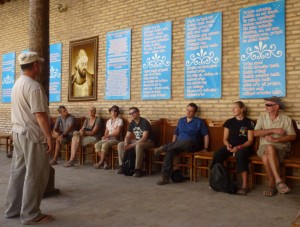 |
We proceeded to Islom-Hoja Medressa near the East Gate. The Medressa now houses the best museum with Khorezm handicrafts, costumes, carpets and woodcarving etc. Utkir took us through within ten minutes. I liked it so much that I returned in the afternoon to spend more time at the museum.Next to the Medressa is Uzbekistan’s tallest minaret at a height of 57metres with bands of turquoise and red tiling built in 1910. I returned at 6pm and paid 3000som to climb the 118 steps to the top to watch sunset.
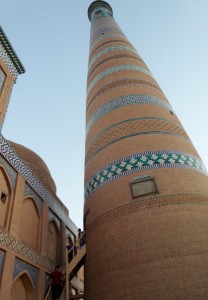 |
The next stop was the Juma Mosque with 218 wooden columns four of which date back to the 10th century. The mosque is atmospheric with the columns. There is also a minaret with 81 steps. But I did not climb as I only wanted to climb the tallest one in Khiva.
The last place Utkir took us to see is a small palace where the four official wives and concubines of the khan stayed. The blue mosaic tiles are beautiful. There is a well in the centre with two drainage holes in the courtyard.
The guided tour ended at 12:30pm. Hortensia and I went to the bazaar to buy fruit and local food. On our way back to the walled city, we had a lovely time mingling with the locals who gave us their plov to try!
While Hortensia headed back to the hotel for a rest, I went to the museum and climbed the watch tower at the Ark (I missed this as I had to return to the hotel during our tour in the Ark). Al gave us a briefing at 4pm about our programme in Turkmenistan. Then I had a leisure stroll and climbed the 118 steps to watch sunset. The tower is dark and scary. I had no head torch. Fortunately I met three young Japanese and Akiko helped me.
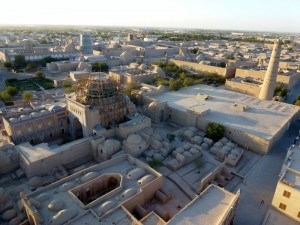 |
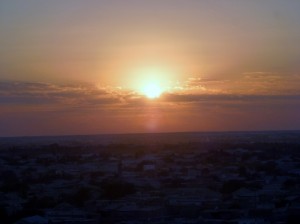 |
I ran into Akiko again on my way to a restaurant. She joined me and met Alex, Finn and John for dinner and told us that she was attracted by Uzbekistan’s history, architecture and beauty and had made the trip. It is amazing to see the number of young Japanese people travelling on their own in Central Asia.
Day 26 (August 20): Khiva, Uzbekistan – Konye Urgench, Turkmenistan (180km)
We set off at 8am and reached the border at Nijazov at 945am. Things went generally smoothly and we exited Uzbekistan around 11am. Then we had to board the truck and drove less than a kilometer to reach the Turkmenistan check point at Shovot.
Remarks
I had an enjoyable time in Uzbekistan. We spent two nights in Tashkent and Khiva and three in Samarkand and Bukhara. Such arrangement is good as we did not need to pack and move every day. I had opportunities to wander around the old towns, meet locals and sampled local cuisines.
I have visited all the four World Heritage Sites in Uzbekistan and appreciate the architecture, the mosaics and different styles of the old town and the buildings. But I have the feeling that some buildings in Bukhara have been over renovated thus losing the feel of authenticity. By comparison I find Shahr- I – Zindah, Khiva and Shakhrisabz authentic and more appealing.
I am sad to see the lovely old towns becoming nothing but huge souvenir bazaars. I think the empty and run-down medressas would be better preserved if put into other usage. Khiva seems to be leading the way in this regard.
There is still so much to see in Uzbekistan. I hope to return one day to explore this country at a leisurely pace!


